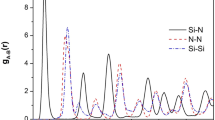Abstract
At high temperature, silicon oxycarbide (SiCO) exhibits excellent mechanical properties and thermal stability. The incorporation of boron in SiCO results in improved performance in creep temperatures. In this work, large-scale molecular dynamics calculations were applied to obtain amorphous SiCO structures containing boron. Phase separation of C–C, B–C and Si–O was achieved for three compositions, and silicon-centered mixed-bond tetrahedrons were reproduced successfully. As the boron content increases, the boron atoms tend to form B–C and B–Si bonds in the voids, which stretches the free carbon network in some instances, causing a increase in C–C distance. Young’s modulus remains stable at high temperature for the high-carbon case, which indicates that the free carbon network plays a critical role in the structural and thermal stability of SiBCO.

Three major typical structures in the cooling down process for silicon boron oxycarbide (Si5BC2O8). Bonds: red Si–O, blue Si–C, black C–C, green B–C, purple Si–B








Similar content being viewed by others
References
Colombo P, Mera G, Riedel R, Sorarù GD (2010) Polymer-derived ceramics: 40 years of research and innovation in advanced ceramics. J Am Ceram Soc 93:1805–1837
Klonczynski A, Schneider G, Riedel R, Theissmann R (2004) Influence of boron on the microstructure of polymer derived SiCO ceramics. Adv Eng Mater 6:64–68
Liebau V, Hauser R, Riedel R (2004) Amorphous SiBCO ceramics derived from novel polymeric precursors. Cr Chim 7:463–469
Saha A, Raj R, Williamson DL (2006) A model for the nanodomains in polymer-derived SiCO. J Am Ceram Soc 89:2188–2195
Tamayo A, Peña-Alonso R, Rubio F, Rubio J, Oteo J (2012) Synthesis and characterization of boron silicon oxycarbide glass fibers. J Non-Cryst Solids 358:155–162
Kousaalya AB, Kumar R, Packirisamy S (2013) Characterization of free carbon in the as-thermolyzed Si-BCN ceramic from a polyorganoborosilazane precursor. J Aav Ceram 2:325–332
Pena-Alonso R, Mariotto G, Gervais C, Babonneau F, Soraru GD (2007) New insights on the high-temperature nanostructure evolution of SiOC and B-doped SiBOC polymer-derived glasses. Chem Mater 19:5694–5702
Laidani NB, Sorarù GD (2015) N-doped polymer-derived Si (N) OC: the role of the N-containing precursor. J Mater Res 30:770–781
Tavakoli AH, Campostrini R, Gervais C, Babonneau F, Bill J, Soraru GD, Navrotsky A (2014) Energetics and structure of polymer-derived Si-(B-) O–C glasses: effect of the boron content and pyrolysis temperature. J Am Ceram Soc 97:303–309
Liao N, Xue W, Zhang M (2011) Molecular dynamics investigation of temperature dependent structural and fracture properties of amorphous silicon nitride. Mater Sci Technol 27:1798–1801
Matsunaga K, Iwamoto Y (2001) Molecular dynamics study of atomic structure and diffusion behavior in amorphous silicon nitride containing boron. J Am Ceram Soc 84:2213–2219
Liao N, Xue W, Zhang M (2012) Effect of carbon content on structural and mechanical properties of SiCN by atomistic simulations. J Eur Ceram Soc 32:1275–1281
Tomar V, Gan M, Kim HS (2010) Atomistic analyses of the effect of temperature and morphology on mechanical strength of Si–C–N and Si–C–O nanocomposites. J Eur Ceram Soc 30:2223–2237
Azamat J, Khataee A, Joo SW (2014) Separation of a heavy metal from water through a membrane containing boron nitride nanotubes: molecular dynamics simulations. J Mol Model 20:1–9
Ansari R, Mirnezhad M, Hosseinzadeh M (2015) Mechanical properties of chiral and achiral silicon carbide nanotubes under oxygen chemisorption. J Mol Model 21:1–7
Liao N, Ma G, Zhang M, Xue W (2012) Effects of SiC particles on mechanical properties of SiCN-based composite by atomistic simulation. Composites Part B 43:1739–1742
Tersoff J (1989) Modeling solid-state chemistry: interatomic potentials for multicomponent systems. Phys Rev B 39:5566
Munetoh S, Motooka T, Moriguchi K, Shintani A (2007) Interatomic potential for Si–O systems using Tersoff parameterization. Comput Mater Sci 39:334–339
Swope WC, Andersen HC, Berens PH, Wilson K (1982) A computer simulation method for the calculation of equilibrium constants for the formation of physical clusters of molecules: application to small water clusters. J Chem Phys 76:637–649
Hoover WG (1985) Canonical dynamics: equilibrium phase-space distributions. Phys Rev A 31:1695
Plimpton S (1995) Fast parallel algorithms for short-range molecular dynamics. J Comput Phys 117:1–19
Schiavon MA, Armelin NA, Yoshida IVP (2008) Novel poly (borosiloxane) precursors to amorphous SiBCO ceramics. Mater Chem Phys 112:1047–1054
Bai H, Wen G, Huang X, Han Z, Zhong B, Hu Z, Zhang X (2011) Synthesis and structural characterization of SiBOC ceramic fibers derived from single-source polyborosiloxane. J Eur Ceram Soc 31:931–940
Bréquel H, Parmentier J, Walter S, Badheka R, Trimmel G, Masse S, Latournerie J, Dempsey P, Turquat C, Desmartin-Chomel A (2004) Systematic structural characterization of the high-temperature behavior of nearly stoichiometric silicon oxycarbide glasses. Chem Mater 16:2585–2598
Moysan C, Riedel R, Harshe R, Rouxel T, Augereau F (2007) Mechanical characterization of a polysiloxane-derived SiOC glass. J Eur Ceram Soc 27:397–403
Acknowledgments
The authors would like to acknowledge the support of the National Natural Science Foundation of China (51675384), Public Welfare Science and Technology Project of Wenzhou City (G20160005), and the High Performance Computing System of Wenzhou University.
Author information
Authors and Affiliations
Corresponding authors
Rights and permissions
About this article
Cite this article
Zhang, M., Liao, N., Xue, W. et al. Large-scale molecular dynamics modeling of boron-doped amorphous SiCO ceramics. J Mol Model 23, 178 (2017). https://doi.org/10.1007/s00894-017-3354-4
Received:
Accepted:
Published:
DOI: https://doi.org/10.1007/s00894-017-3354-4




